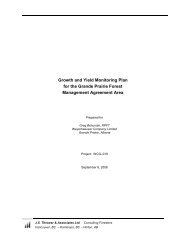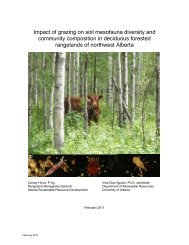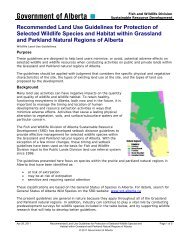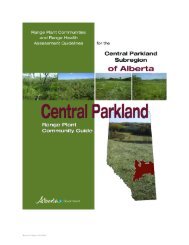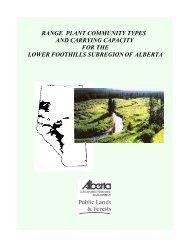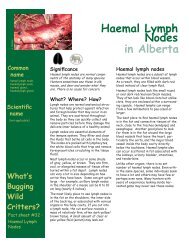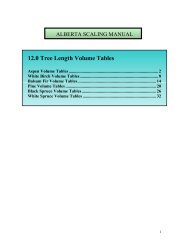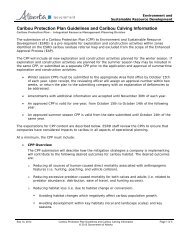Foothills Fescue Range Plant Community Guide - Sustainable ...
Foothills Fescue Range Plant Community Guide - Sustainable ...
Foothills Fescue Range Plant Community Guide - Sustainable ...
Create successful ePaper yourself
Turn your PDF publications into a flip-book with our unique Google optimized e-Paper software.
1.0 Introduction and Background<br />
1.1 This guide is an aide to range health assessment<br />
This plant community guide is provided as an essential reference for range health 3<br />
assessment in the <strong>Foothills</strong> <strong>Fescue</strong> prairie. <strong>Range</strong> health assessment (Adams et al. 2003)<br />
is a new approach that builds on the traditional range condition concept that considers<br />
plant community type in relation to site potential, but also adds new indicators of<br />
important natural processes and functions.<br />
<strong>Range</strong> management strives to protect and enhance the soil and vegetation complex while<br />
maintaining or improving the output of consumable products along with a wide range of<br />
other values and natural functions. Ranchers and resource managers have used the<br />
concept of range condition in Alberta to measure any deterioration that has taken place<br />
within a range plant community due to disturbances, especially those from livestock<br />
grazing. <strong>Range</strong> condition has been rated in relation to a concept of site potential or<br />
climax vegetation. The first stocking guide for the Grassland Natural Region The <strong>Guide</strong><br />
to <strong>Range</strong> Condition and Stocking Rates for Alberta Grasslands, was patterned after the<br />
US Department of Agriculture - Soil Conservation Service “range site” concept (Smoliak<br />
et al 1966, Wroe et al 1988). Since the first guide was published, several generations of<br />
ranchers and range resource managers have developed an understanding of range sites<br />
and the ecological conditions that they represent. The new range health tools are<br />
similarly intended for use by range resource managers and ranchers and for a wide<br />
variety of other groups and users that share an interest in healthy rangelands.<br />
<strong>Range</strong> managers generally strive to maintain plant communities at or near the climax or<br />
potential natural community (PNC) stage in order to provide higher levels of ecological<br />
functioning and to sustain an optimum flow of products like livestock forage. Healthy<br />
range plant communities perform important ecological functions and provide a broader<br />
suite of goods and services than lower seral stages. Early and mid seral stages need to be<br />
present in the landscape to represent the full range of natural variation that existed prior<br />
to European settlement, but should not be predominant.<br />
Our use of the term “range health” instead of “range condition” flags a change in<br />
approach that builds on the traditional range condition approach that considers plant<br />
community type in relation to site potential, but also adds new indicators of important<br />
natural processes and functions, important functions performed by healthy rangelands.<br />
We use the term range health to mean the ability of rangeland to perform certain<br />
ecological functions. These functions include:<br />
• net primary production,<br />
3 The range health approach is being adopted in the United States and Canada by a variety of<br />
agencies and organizations including the Natural Resource Conservation Service (NRCS), the US Forest<br />
Service and the Bureau of Land Management (Butler et al 1997, Busby et al 1994, and Task Group on<br />
Unity in Concept and Terminology 1995). The Alberta <strong>Range</strong>land Health Assessment project will provide<br />
new rangeland monitoring tools for Alberta rangelands (Alberta <strong>Range</strong> Health Task Group 1999).<br />
1



